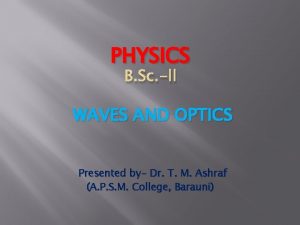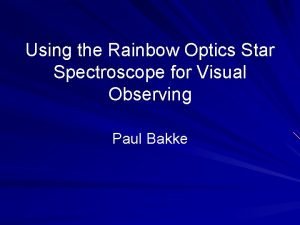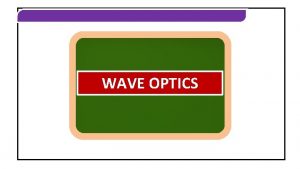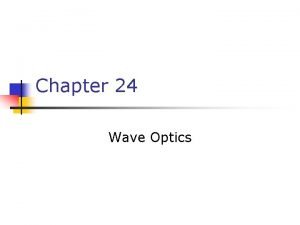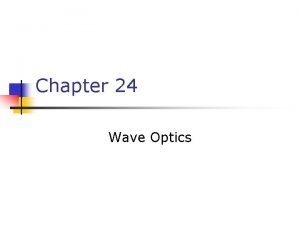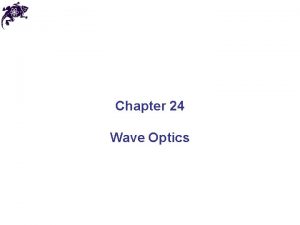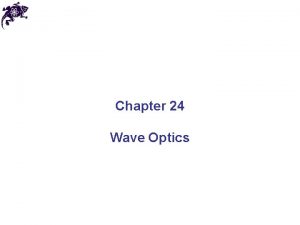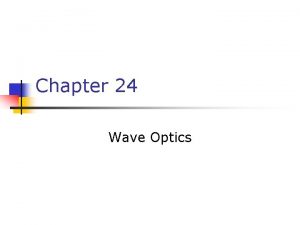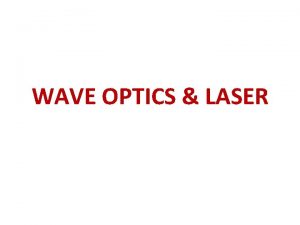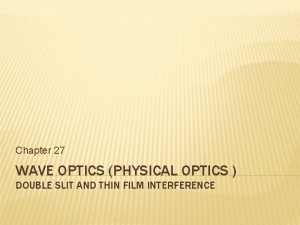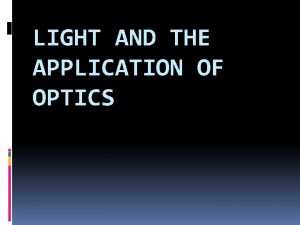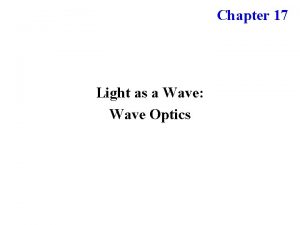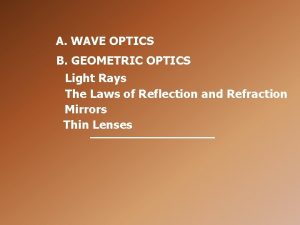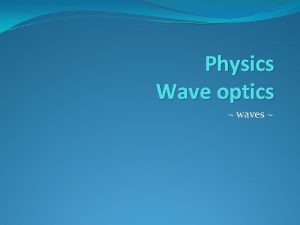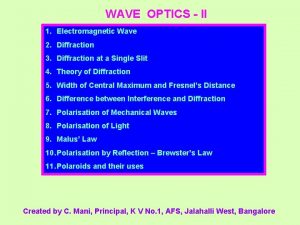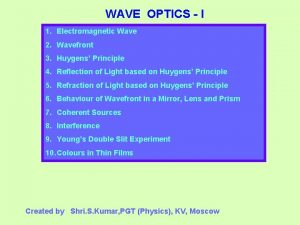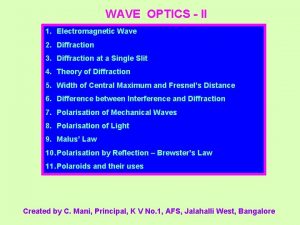Chapter 33 Wave Optics Topics that we will





























- Slides: 29

Chapter 33 – Wave Optics Topics that we will cover: Light Diffraction with: Double Slits Diffraction Gratings Single Slits Circular Apertures Huygens Principle Interferometry Note that this is Chapter 22 in the 3 rd edition of Knight.

Let’s start with a general question. If you were to shine a big laser beam through the two slits as shown below, what sort of pattern would you expect on the wall behind the two-slit screen? http: //www. colorado. edu/physics/2000/index. pl

Interference of Light http: //vsg. quasihome. com/interfer. htm

A slightly different representation of double-slit interference.

How can we figure out where the bright spots on the screen are? Well, we’ve already begun to do this when we looked at interference in sound waves. Remember this problem.

r 2 y = Ltan r 1 d . L What needs to happen is that r = m

y = Ltan d Now, the next step might sound a bit cheesy, but it works. . L For light, the distance d << L thus we get: r = dsin

So, back to the light case, we get: m = dsin But wait, is usually very small in this case, thus we get to use our friend THE SMALL ANGLE APPROXIMATION! Thus, we get m = d or Where m = 0, 1, 2, 3, …

Where m = 0, 1, 2, 3, … Usually, is difficult to measure, so we measure the distance from the central max to the fringe (y) instead.

http: //vsg. quasihome. com/interfer. htm

Quick Quiz Questions If tells us where the bright lines are, create a formula that will tell us where the dark lines are.

Meanwhile, if you were real industrious, you could find out how bright each bright spot is:

If you shine a green laser (with =5000Å) through two slits that are 3 m apart how far apart with the first fringe be from the central bright fringe if the double-slit screen is 20 cm away from the projection screen?

Diffraction Gratings work similarly to a double-slit, except this time we can’t use the small angle approximation. dsin m = m ym = Ltan m y 2 y 1 d L

Light from a sodium lamp passes through a diffraction grating having 1000 slits per mm. The interference pattern is viewed on a screen 1. 000 meters behind the grating. Two bright yellow fringes are visible 72. 88 cm and 73. 00 cm from the central maximum. What are the wavelengths of these two fringes? dsin m = m ym = Ltan m

Sample Problem: An x-ray source is bounced of a salt crystal. The x-ray pattern created on a screen a distance L above the crystal looks like this. What is the spacing between x-ray dots on a screen place 1. 0 meter away from the top surface of the salt crystal if a) =10 nm b) =. 10 nm Cl- spacing is 0. 4 nm

What if we try to pass multiple colors through a diffraction grating?

For a single slit system: Where ym is the position of the m’th dark fringe p = 1, 2, 3, … a = the width of a single slit Thus, the width of the central bright spot must be:

Single Slit Diffraction http: //www. phys. hawaii. edu/~teb/optics/java/slitdiffr/

Circular Aperture Diffraction

Circular Aperture Diffraction The position of the first dark fringe is:

Huygens’ Principle: 1) Each point on a wave front is the source of a spherical “wavelet” that spreads out at the wave speed. 2) At a later time, the shape of the wave front is the line tangent to all the wavelets. Huygens’ Principle for reflection and refraction http: //www. walter-fendt. de/ph 14 e/huygenspr. htm

Huygens’ Principle can also nicely explain the wavefront you see when you drop a pebble in a pool of water.



Sample Problem 22. 43 White light (400 -700 nm) incident on a 600 line/mm diffraction grating produces rainbows of diffracted light. What is the width of the first-order rainbow on a screen 2. 0 m behind the grating?

Interferometery http: //www. youtube. com/watch? v=8 QUhg. Yax. Wao&feature=related http: //www. youtube. com/watch? v=7 a. R 8 Hm. Wj. Hs 4&feature=related

Chapter 33 – Wave Optics Topics that we covered: Light Diffraction with: Double Slits Diffraction Gratings Single Slits Circular Apertures Huygens Principle Interferometry

Chapter 33 – Wave Optics is the study of Light There are two main way to describe light: The Ray Model (or the particle model) The Photon Model (or the wave model)
 Difference between ray optics and wave optics
Difference between ray optics and wave optics Http //vsg.quasihome.com
Http //vsg.quasihome.com Reflection and refraction venn diagram
Reflection and refraction venn diagram Wave optics b.sc physics
Wave optics b.sc physics Ngoại tâm thu thất chùm đôi
Ngoại tâm thu thất chùm đôi Block nhĩ thất độ 3
Block nhĩ thất độ 3 Thơ thất ngôn tứ tuyệt đường luật
Thơ thất ngôn tứ tuyệt đường luật Thơ thất ngôn tứ tuyệt đường luật
Thơ thất ngôn tứ tuyệt đường luật Chiến lược kinh doanh quốc tế của walmart
Chiến lược kinh doanh quốc tế của walmart Tìm vết của đường thẳng
Tìm vết của đường thẳng Con hãy đưa tay khi thấy người vấp ngã
Con hãy đưa tay khi thấy người vấp ngã Tôn thất thuyết là ai
Tôn thất thuyết là ai Gây tê cơ vuông thắt lưng
Gây tê cơ vuông thắt lưng Sau thất bại ở hồ điển triệt
Sau thất bại ở hồ điển triệt Light waves are electromagnetic waves true or false
Light waves are electromagnetic waves true or false Long waves and short waves
Long waves and short waves Difference between full wave and half wave rectifier
Difference between full wave and half wave rectifier Transverse and longitudinal waves both *
Transverse and longitudinal waves both * Full wave rectifier vs half wave rectifier
Full wave rectifier vs half wave rectifier Full wave rectifier with centre tapped transformer
Full wave rectifier with centre tapped transformer P and s wave chart
P and s wave chart Full wave rectified sine wave fourier series
Full wave rectified sine wave fourier series Longitudinal wave
Longitudinal wave Wave wave repeating
Wave wave repeating Odd quarter wave symmetry
Odd quarter wave symmetry Mechanical wave and electromagnetic wave
Mechanical wave and electromagnetic wave Example of mechanical waves
Example of mechanical waves Transverse wave and longitudinal wave example
Transverse wave and longitudinal wave example Rainbow optics star spectroscope
Rainbow optics star spectroscope Gestaltism
Gestaltism



